光学、光电子学领域的著名学会、期刊及文献搜索平台
SPIE数据库介绍

下载文献引文: 在每一篇文献的标题前都有一个,钩选 这个框,然后在下拉表中选择需要下载的 引文格式“Download Citation(s)”,亦可直 接查看引文“View Citation(s)”。
电子邮件通知 点击“My E-mail Alerts”,选择按 出版物和主 题接受电子邮件通知,会根据需要将内容发送 给你。
用户有两种方式访问SPIE数字图书馆 直接访问SPIE数字图书馆 通过美国物理联合会AIP的Scitation平台
3.1直接进入SPIE数字图书馆平台
选择检索方式
浏览会议录入口
浏览期刊入口
出版物列表和 回溯年限
检索方法
浏览
检索
3.1.1浏览
SPIE数字图书馆主页有浏览期刊和数据库 的入口,SPIE的会议录回溯至1998年,但 在1998年之前出版的会议录也有部分被收 录在数字图书馆中。按年份“By Year”和 按卷号“By Volume No.”等多种形式浏览 会议录,可以获得被收录在数字图书馆中 的会议录的完整列表。
点击
‘选择 相关性 出版物类型 选项 选择检 索字段
选择检索结果 的排列顺序
按学科(技术)浏览
点击任一专题进一步浏览该 学科的分支
点击子学科名称,浏览会议 情况
点击会议录名称,浏览会议 录目次
点击所选目次浏览全文
全文显示界面
期刊浏览界面(浏览SPIE收 录的四种专业期刊)
可以进行最新一期、 最新一卷和所有卷 期的浏览
2.进入系统
进入南京理工大学主页 网址: 点击电子资源中的外文数据库,选择SPIE 全文数据库的链接即可进入检索系统的界 面。
图书馆主页
SPIE 检索主页
提供快 速检索 和级检 索
国外光学电子类核心期刊

序 刊名
号
中文译名
中图刊号 出版国
Journal of magnetism and magnetic
1
磁学和磁性材料杂志
materials
2 Electronics letters
电子学快报
536LB002 736C0061
荷兰 英国
3 IEEE transactions on magnetics
IEEE 磁学汇刊
IEEE 通信汇刊 IEEE-TM S 电子材料杂志 IEEE 信号处理汇刊 IEEE 通信选题杂志 IEEE 应用超导汇刊 IEEE 天线与传播汇刊 微电子工程 半导体科学与技术 IEEE 固态电路杂志 IEEE 微机电系统杂志 微电子学可靠性 IEEE 无线通信杂志 IEEE 无线通信处理杂志
730B0001TCO
537LB053 537C0075 537B0001 546B00 11 798B0072 537LB010 537B0002
14 Journal of lightwave technology
光波技术杂志
15 Journal of the American Society for Mass 美国质谱学会志
中文译名
中图刊号
出版
IEEE transactions on circuits and systems. Ⅰ, Regular IEEE 电路与系统汇刊.第 1 辑,
21 p ap ers
一般论文
730B0001TCS1
美国
IEEE transactions on circuits and systems for video IEEE 视频技术电路与系统汇刊 22
28 briefs
光学类期刊投稿排行修订稿
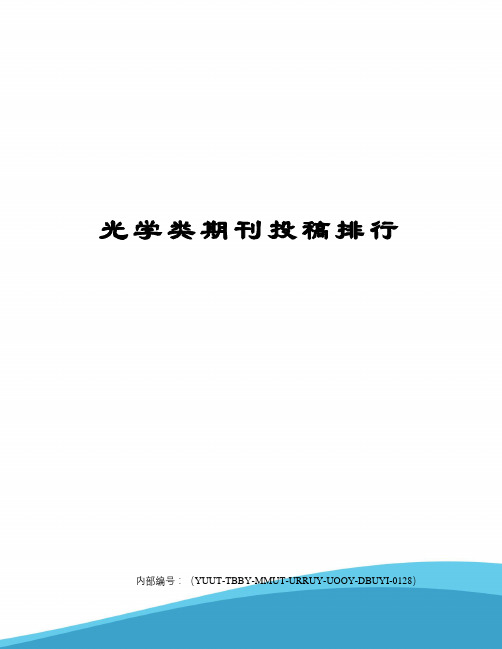
光学类期刊投稿排行内部编号:(YUUT-TBBY-MMUT-URRUY-UOOY-DBUYI-0128)1光学学报2中国激光(属于超一流中文光学杂志),与COL一起是中国激光杂志社旗下的三大王牌杂志,也是国内光学杂志的皇帝,每篇文章有3位审稿人审稿,文章严谨程度非常高,其中COL已经被SCI收录(SCI最新影响因子0.8左右),光学学报与中国激光是中文SCI期刊的候选期刊。
3光谱与光谱学分析【SCI(次等)】:由于自引率太高,已经多次被JCR警告,但俗话说瘦死的骆驼比马大,任然属于光学顶尖级杂志。
4光电子.激光(2009年之前分EI核心和EI 非核心,光电子激光是最早的EI核心期刊之一,每篇文章均被EI compendex 收录),在光电子学方面报到的论文最多,属于一流杂志的代表,也是唯一一本由大学主办的学术期刊(前10名中),相当的不容易。
5光学精密工程(同光电子.激光实力相当,排名也可定为第四),由于期刊报道的内容没有光电子激光报道的内容专业性和新颖性强,暂定于第5吧。
6强激光与粒子束(工程科学院举办),影响因子0.9左右,发展迅速,现加入到了中国光学期刊网,推广了知名度,属于一流杂志,此杂志与中国激光杂志的研究内容很像,是中国激光杂志的小弟,如果投稿中国激光或者光学学报被退,这个杂志则是您稿件去的最佳方向。
7光子学报(在09年以前属于EI非核心),在西安光机所得率领下不断发展,10年后一直被EI核心检索,近几年凭着自己的地位和努力,经常举办或者参加会议文章的出版,在陕西地方区域具有相当的影响力,属于二流杂志的领导。
8发光学报:在中科院长春光机所领导下,终于从10年开始被EI收录,并从双月刊转为月刊,发展迅速,在11年被评为百种杰出学术期刊,不过后门开的较大。
9光电工程:老牌子光电期刊,这几年走了点下坡路,但任然是光电期刊类的中流砥柱。
希望在后几年能重振雄风!10红外与激光工程(从10开始被EI收录,且从双月刊转为月刊,影响因子0.7左右)发展速度与历程和发光学报相似,现在稿源丰富,每期刊登45篇论文左右,是个不可多得的光学期刊之一。
SPIE全文电子期刊及会议录数据库使用指南
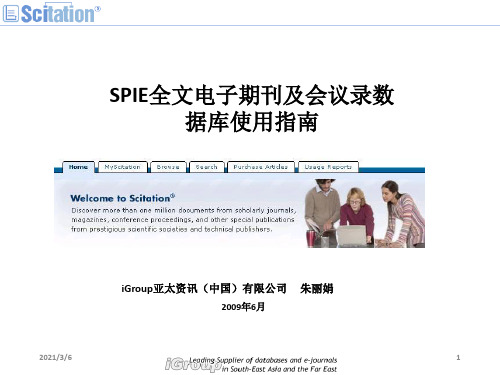
2021/3/6
7
SPIE期刊列表
下载地址:/downlist.asp?ClassID=2
2021/3/6
8
SPIE期刊品质
* 数据来源:2008 JCR
2021/3/6
9
SPIE数据库的基本功能
• SPIE数据库访问平台 ——SPIE Digital Library平台 ——Scitation平台
• 平台浏览和检索
2021/3/6
24
Scitation平台概况
• 一个获得高品质学术文献的在线入口 • 30多家声誉卓著的学协会和技术出版社 • 近200种出版物 • 内容包括了期刊、杂志、会议录和其他
• 一个功能强大的在线平台 • 链接到多种外部信息资源:ISI’s Web of Science, MEDLINE, ChemPort/Chemical Abstracts ServicIRES • 提供文章的被引用链接
14
论文摘要页面
2021/3/6
15
作者检索
2021/3/6
16
浏览全文
HTML格式
Section HTMPLD格F式格式
2021/3/6
17
参考文献链接
参考文献的链接可以链接到Scitation内部资源,和以下外部 资源:
•IEE's Inspec Database •Los Alamos National Laboratory (LANL) E-print Server •Stanford Linear Accelerator Center Stanford Public Information REtreival System (SLAC-SPIRES) Database •The National Library of Medicine's (MEDLINE) Database. •PROLA or The Physical Review Online Archive Database •SPIRES/SLAC •EDPS (Europhysics Journal) •IOPP (Institute of Physics Publishing) •PubMed (Medline) •JJAP (Japanese Physics Society) •Science Magazine •Nature
光学类中文核心期刊列表

光学类中文核心期刊列表SCI类光谱学与光谱分析本刊收录在: Ei Compendex (2013年)本刊收录在: Ei Compendex (2015年)本刊收录在Web of Science: SCIE(2016版)本刊收录在:中文核心期刊要目总览(2014年版) EI类光电子·激光本刊收录在: Ei Compendex (2013年)本刊收录在: Ei Compendex (2015年)本刊收录在:中文核心期刊要目总览(2014年版)光子学报本刊收录在: Ei Compendex (2013年)本刊收录在: Ei Compendex (2015年)本刊收录在:中文核心期刊要目总览(2014年版)光学学报本刊收录在: Ei Compendex (2013年)本刊收录在: Ei Compendex (2015年)本刊收录在:中文核心期刊要目总览(2014年版)发光学报本刊收录在: Ei Compendex (2013年)本刊收录在: Ei Compendex (2015年)本刊收录在:中文核心期刊要目总览(2014年版)光学精密工程本刊收录在: Ei Compendex (2013年)本刊收录在: Ei Compendex (2015年)本刊收录在:中文核心期刊要目总览(2014年版)红外与激光工程本刊收录在: Ei Compendex (2013年)本刊收录在: Ei Compendex (2015年)本刊收录在:中文核心期刊要目总览(2014年版)强激光与粒子束本刊收录在: Ei Compendex (2013年)本刊收录在: Ei Compendex (2015年)本刊收录在:中文核心期刊要目总览(2014年版)中国激光本刊收录在: Ei Compendex (2013年)本刊收录在: Ei Compendex (2015年)本刊收录在:中文核心期刊要目总览(2014年版)纯中文核心期刊类激光杂志本刊收录在:中文核心期刊要目总览(2014年版)激光与红外本刊收录在:中文核心期刊要目总览(2014年版)电光与控制本刊收录在:中文核心期刊要目总览(2014年版)光电工程本刊收录在:中文核心期刊要目总览(2014年版)光散射学报本刊收录在:中文核心期刊要目总览(2014年版)光学技术本刊收录在:中文核心期刊要目总览(2014年版)量子光学学报本刊收录在:中文核心期刊要目总览(2014年版)应用光学本刊收录在:中文核心期刊要目总览(2014年版)激光技术本刊收录在:中文核心期刊要目总览(2014年版)应用激光本刊收录在:中文核心期刊要目总览(2014年版)激光与光电子学进展本刊收录在:中文核心期刊要目总览(2014年版)光通信研究本刊收录在:中文核心期刊要目总览(2014年版)半导体光电本刊收录在:中文核心期刊要目总览(2014年版)光通信技术本刊收录在:中文核心期刊要目总览(2014年版)。
光学与光通信期刊汇总

国外光学与光通信期刊(SCI&EI检索)建议低年级研究生常看:IEEE Communications MagazineIEEE Journal of Lightwave TechIEEE Photonic Technology LettersMicrowave and Optical Tech. Lett.Optics Communications (Elsevier)Communications, IEEE Transactions onIEEE Communications Letters系统和器件类期刊1.Physics Review Letter2.Progress in Optics3.Optics Letters (OSA)4.IEEE Journal of Quantum Electronics5.Applied Physics Letter6.Chinese Physics B7.Journal of The Society of America B: OpticalPhysics (OSA)8.Applied Physics B: Lasers and Optics9.Optics Express (OSA)10.Journal of The Society of America A: OpticsImage Science and Vision (OSA)11.Journal of Lightwave Tech (IEEE)12.Applied optics (OSA)13.Optics Communications (Elsevier)14.Optical Fiber Technology (Elsevier)15.Pure and Applied Optics16.Quantum and Semiclassical Optics17.Journal of Morden Optics 18.Optical engineering (SPIE)19.J. of Nonlinear Optical Physics & Materials20.Optical and Quantum Electronics21.Journal of Optics B: Quantum andSemiclassical Optics (IOP & EOS)22.Optics and Spectroscopy23.Optics and Laser Technology (Elsevier)24.Journal of Optics-Nouvelle Revue D Optique25.Optical Review26.Microwave and Optical Tech. Lett.27.Journal of Optics A: Pure and Applied Optics(IOP & EOS)28.Fiber and Integrated Optics29.Journal of Optical Technology(俄语英译)30.Optica Applicata31.Optics and Lasers in Engineering (Elsevier)32.ADV ANCES IN ATOMIC MOLECULARAND OPTICAL PHYSICSMicrowave Theory and Techniques, IEEE Transactions on IET Journal /journals中国物理chinese Journal of physicschinese physics letterchinese optical letter (国内)Semiconductor Science and Technology物理学报IEEE Communications MagazineIEEE Communications LettersIEICE Transactions on CommunicationsApplied Physics B-Laser OpticsJournal of Physics D-Applied PhysicsChinese Journal of ElectronicsCommunications Theoretical in PhysicsJournal of the Korean Physical SocietyIEEE Wireless Communications Magazine/livepubs/pci/info/pub_guidelines.html网络类期刊IEEE Journal of Lightwave Tech.Optical engineering (SPIE)IEEE Transactions on Network and Service Management(2013新创)IEEE Transactions on Communications,IEEE/ACM Transactions on Networking,IET NetworksIEEE Communications MagazineIEEE Communications LettersJournal of Optical Networking (OSA)Journal of Optical Communications and Networking (OSA)Photonic Network CommunicationsJournal of Communications and Networks韩国(http://jcn.or.kr)IEICE transactions on Communications SCI (日本)Chinese Journal of Electronics SCI (电子学报)International Journal of Network Management – Wiley (IF 0.222)Optik国外仅被EI检索的期刊1.optical communication and network EI2.Journal of Optical Communication3.International Journal of Computational Science and Engineering (IJCSE) 台湾国内仅被EI检索的期刊1.中国邮电高校学报英文版2.高技术通讯High Technologies Letter EI3.激光技术EI4.光电子激光EI5.Acta Photonica Sinica 光子学报;6.Chinese Phys, Lett.7.Chinese Optical Lett.中国激光;8.光谱学与光谱分析9.光电工程;10.光学学报;11.红外技术12.光学技术13.激光与红外14.激光杂志15.应用激光半导体光电我们经常投稿的SCI期刊O Optics Communication 荷兰O IEEE Photonic Technology LettersO Microwave and Optical Technology Letters 美国O Chinese Optical LettersO Optical EngineeringOLT Optical Laser Tech。
SPIE数字图书馆及其检索_马景娣
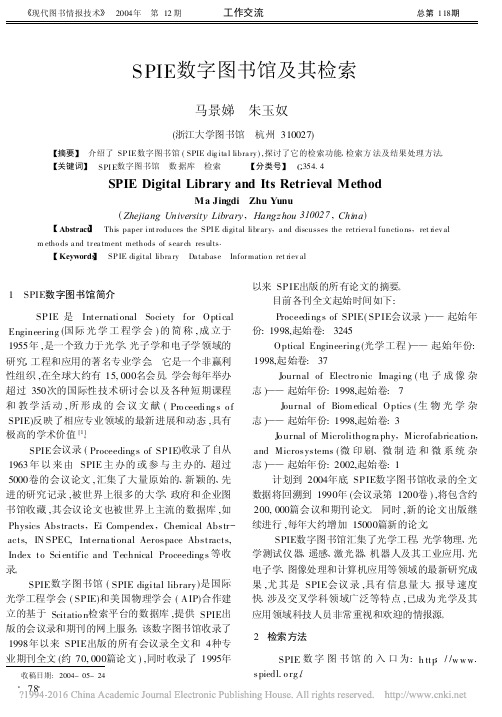
S PIE 数字图书馆及其检索马景娣 朱玉奴(浙江大学图书馆 杭州310027) 【摘要】 介绍了SP IE 数字图书馆(SPIE dig ita l libra ry ),探讨了它的检索功能、检索方法及结果处理方法。
【关键词】 SPI E 数字图书馆 数据库 检索 【分类号】 G 354.4SPIE Digital Library and Its Retrieval MethodMa Jingdi Zhu Yunu(Zhejiang University Library ,Hangzhou 310027,China )【Abstract】 This paper int roduces the SPI E digital libr ar y ,a nd discusses the retrieva l functio ns ,ret riev al m etho ds a nd tr ea tment methods of sear ch results .【Keywords 】 SP IE digital libra ry Da tabase Infor matio n ret riev al 收稿日期:2004-05-241 SPIE 数字图书馆简介 SPIE 是International Society for OpticalEngineering (国际光学工程学会)的简称,成立于1955年,是一个致力于光学、光子学和电子学领域的研究、工程和应用的著名专业学会。
它是一个非赢利性组织,在全球大约有15,000名会员。
学会每年举办超过350次的国际性技术研讨会以及各种短期课程和教学活动,所形成的会议文献(Pro ceeding s o f SPIE)反映了相应专业领域的最新进展和动态,具有极高的学术价值[1]。
SPIE 会议录(Proceeding s of SPIE )收录了自从1963年以来由SPIE 主办的或参与主办的、超过5000卷的会议论文,汇集了大量原始的、新颖的、先进的研究记录,被世界上很多的大学、政府和企业图书馆收藏,其会议论文也被世界上主流的数据库,如Physics Abstracts ,Ei Compendex ,Chemical Abstr -acts,IN SPEC,Interna tional Aerospace Abstracts,Index to Scientific and Technical Proceeding s 等收录。
光学工程主要协会、及章程、出版刊物

7-9周第一次作业光电学院2120130544 黄秀杰一、光学工程专业的主要协/学会1、中国光学学会主办刊物:中国光学学会主办刊物8种:他们是《光学学报》、《中国激光》、《红外与毫米波学报》、《光子学报》、《光谱学与光谱分析》、《中国激光医学杂志》、《光机电信息》和《ChineseOpticsLetters》,其中中文刊物7种,英文刊物1种。
重要章程第二条本会的性质:中国光学学会是全国光学科技工作者自愿组成并依法登记的全国性、学术性、公益性和非营利性的法人社会团体,是中国科学技术协会(简称中国科协)的组成部分,是党和政府发展中国光学科技事业的重要社会力量。
第三条本会的宗旨:遵守宪法、法律、法规和国家政策,遵守社会道德风尚,团结广大光学科技工作者,开展光学科技国际国内学术交流与合作,促进我国光学事业的发展。
第四条本会接受业务主管单位中国科协和社团登记管理机关国家民政部的业务指导和监督管理。
2.国际光学工程学会(Society of Photo-Optical Instrumentation Engineers,SPIE)SPIE 期刊光学工程 (Optical Engineering ) ,回溯至 1990 年。
生物光学期刊 (Journal of Biomedical Optics) ,回溯至 1996 年。
电子成像期刊 (Journal of Electronic Imaging) ,回溯至 1992 年。
微印刷、微制造和微系统期刊 (Journal of Microlithography, Microfabrication,& Microsystems) , 2002 年创刊。
应用遥感期刊 (Journal of Applied Remote Sensing) , 2007 年创刊。
纳米光子学期刊 (Journal of Nanophotonics) , 2007 年创刊。
3.美国光学学会(OSA)主要期刊:Applied Optics、Applied Spectroscopy、Chinese Optics Letters、J. Opt. Soc. Am.、J. Opt. Soc. Am. A、J. Opt. Soc. Am. B、Journal of Display Technology [A joint IEEE/OSA publication]、Journal of Lightwave Technology、Journal of Optical Networking二、光学工程专业国内外最重要的三种期刊1、光学学报英文名称:Acta Optica Sinica主管单位:中国科学技术协会主办单位:中国光学学会A.刊期:月刊b.国际刊号:0253-2239国内刊号:31-1252/O4c.中文期刊影响因子(参考CNKI最新数据)复合影响因子 2.419综合影响因子 2.04d.发文特点(1) 题目、摘要来稿标题应鲜明,字数在20字以内,不使用外文缩写词。
journal of lightwave technology投稿经历

以下是一份可能的投稿经历:投稿背景在光学领域,Journal of Lightwave Technology(JLT)是一本具有较高影响力的国际学术期刊。
该期刊主要关注光纤通信、光学网络、光波导、光子器件等领域的研究。
对于光学领域的研究者来说,能够在 JLT 上发表论文,意味着得到了业界的认可。
因此,投稿到 JLT 是许多光学研究者的目标。
投稿过程在投稿前,作者需要仔细阅读 JLT 的投稿指南,确保论文符合期刊的要求。
然后,作者需要在线提交论文,并按照要求提供必要的文件和信息。
在线提交系统通常需要填写论文标题、摘要、关键词、作者信息等。
提交后,作者会收到一封确认邮件,确认论文已经成功提交。
审稿人反馈论文提交后,将由 JLT 的编辑进行初步审查。
如果编辑认为论文适合期刊,将邀请相关领域的专家对论文进行同行评审。
同行评审通常需要几周到几个月的时间,具体时间取决于专家的反馈速度和编辑的安排。
评审结果可能包括接受、拒绝或需要修改后重新提交。
如果论文被接受,作者将收到一封来自编辑的录用通知,通知论文将被发表在 JLT 上。
作者修改与接受如果审稿人认为论文需要修改,作者需要进行相应的修改,并重新提交论文。
在重新提交之前,作者应该仔细检查论文,确保所有的修改都符合要求。
重新提交后,审稿人将对修改后的论文进行再次评审。
如果审稿人满意,论文将被接受并发表在 JLT 上。
作者通常会收到一封来自编辑的接受通知,通知论文将被发表在 JLT 上。
投稿心得对于光学研究者来说,向 JLT 投稿是一项非常重要的任务。
在投稿过程中,作者需要注意以下几点:1. 仔细阅读投稿指南,确保论文符合期刊的要求;2. 尽量选择与论文主题相关的期刊投稿;3. 提交前仔细检查论文,确保格式、语言、拼写等都符合要求;4. 如果审稿人提出修改意见,作者应该认真对待并尽快修改;5. 如果论文被拒绝,不要灰心丧气,要认真分析原因并继续努力。
光学类期刊投稿排行
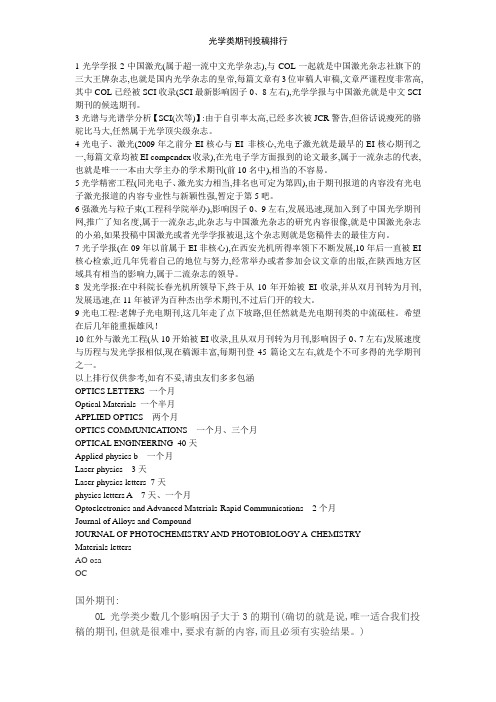
1光学学报2中国激光(属于超一流中文光学杂志),与COL一起就是中国激光杂志社旗下的三大王牌杂志,也就是国内光学杂志的皇帝,每篇文章有3位审稿人审稿,文章严谨程度非常高,其中COL已经被SCI收录(SCI最新影响因子0、8左右),光学学报与中国激光就是中文SCI 期刊的候选期刊。
3光谱与光谱学分析【SCI(次等)】:由于自引率太高,已经多次被JCR警告,但俗话说瘦死的骆驼比马大,任然属于光学顶尖级杂志。
4光电子、激光(2009年之前分EI核心与EI 非核心,光电子激光就是最早的EI核心期刊之一,每篇文章均被EI compendex收录),在光电子学方面报到的论文最多,属于一流杂志的代表,也就是唯一一本由大学主办的学术期刊(前10名中),相当的不容易。
5光学精密工程(同光电子、激光实力相当,排名也可定为第四),由于期刊报道的内容没有光电子激光报道的内容专业性与新颖性强,暂定于第5吧。
6强激光与粒子束(工程科学院举办),影响因子0、9左右,发展迅速,现加入到了中国光学期刊网,推广了知名度,属于一流杂志,此杂志与中国激光杂志的研究内容很像,就是中国激光杂志的小弟,如果投稿中国激光或者光学学报被退,这个杂志则就是您稿件去的最佳方向。
7光子学报(在09年以前属于EI非核心),在西安光机所得率领下不断发展,10年后一直被EI 核心检索,近几年凭着自己的地位与努力,经常举办或者参加会议文章的出版,在陕西地方区域具有相当的影响力,属于二流杂志的领导。
8发光学报:在中科院长春光机所领导下,终于从10年开始被EI收录,并从双月刊转为月刊,发展迅速,在11年被评为百种杰出学术期刊,不过后门开的较大。
9光电工程:老牌子光电期刊,这几年走了点下坡路,但任然就是光电期刊类的中流砥柱。
希望在后几年能重振雄风!10红外与激光工程(从10开始被EI收录,且从双月刊转为月刊,影响因子0、7左右)发展速度与历程与发光学报相似,现在稿源丰富,每期刊登45篇论文左右,就是个不可多得的光学期刊之一。
中文光学sci
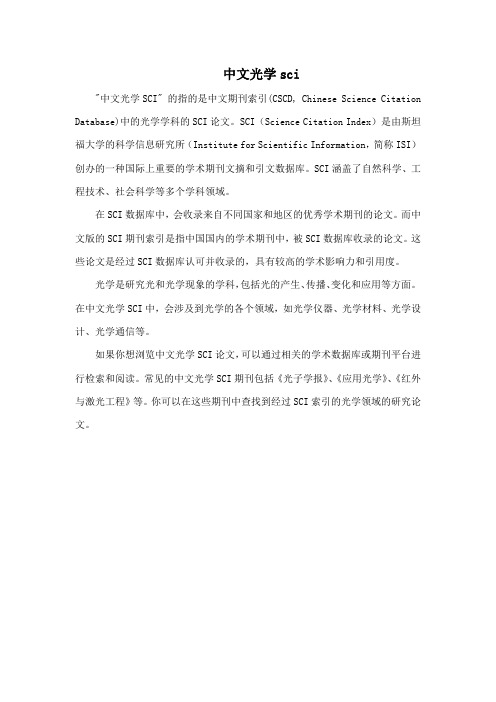
中文光学sci
"中文光学SCI" 的指的是中文期刊索引(CSCD, Chinese Science Citation Database)中的光学学科的SCI论文。
SCI(Science Citation Index)是由斯坦福大学的科学信息研究所(Institute for Scientific Information,简称ISI)创办的一种国际上重要的学术期刊文摘和引文数据库。
SCI涵盖了自然科学、工程技术、社会科学等多个学科领域。
在SCI数据库中,会收录来自不同国家和地区的优秀学术期刊的论文。
而中文版的SCI期刊索引是指中国国内的学术期刊中,被SCI数据库收录的论文。
这些论文是经过SCI数据库认可并收录的,具有较高的学术影响力和引用度。
光学是研究光和光学现象的学科,包括光的产生、传播、变化和应用等方面。
在中文光学SCI中,会涉及到光学的各个领域,如光学仪器、光学材料、光学设计、光学通信等。
如果你想浏览中文光学SCI论文,可以通过相关的学术数据库或期刊平台进行检索和阅读。
常见的中文光学SCI期刊包括《光子学报》、《应用光学》、《红外与激光工程》等。
你可以在这些期刊中查找到经过SCI索引的光学领域的研究论文。
光学类期刊投稿排行
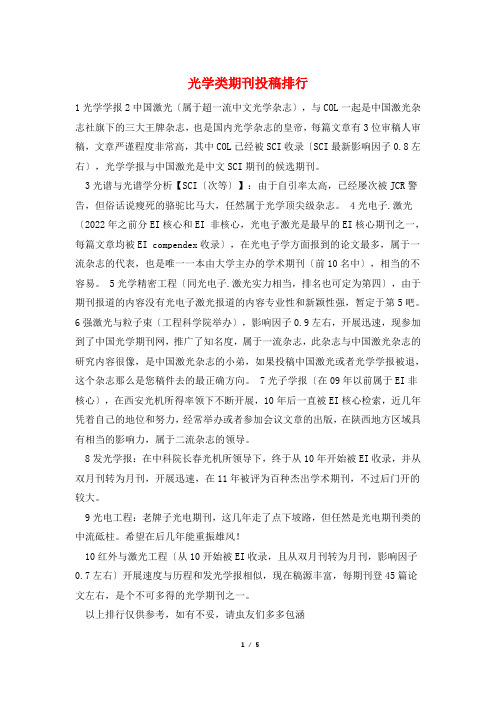
光学类期刊投稿排行1光学学报2中国激光〔属于超一流中文光学杂志〕,与COL一起是中国激光杂志社旗下的三大王牌杂志,也是国内光学杂志的皇帝,每篇文章有3位审稿人审稿,文章严谨程度非常高,其中COL已经被SCI收录〔SCI最新影响因子0.8左右〕,光学学报与中国激光是中文SCI期刊的候选期刊。
3光谱与光谱学分析【SCI〔次等〕】:由于自引率太高,已经屡次被JCR警告,但俗话说瘦死的骆驼比马大,任然属于光学顶尖级杂志。
4光电子.激光〔2022年之前分EI核心和EI 非核心,光电子激光是最早的EI核心期刊之一,每篇文章均被EI compendex收录〕,在光电子学方面报到的论文最多,属于一流杂志的代表,也是唯一一本由大学主办的学术期刊〔前10名中〕,相当的不容易。
5光学精密工程〔同光电子.激光实力相当,排名也可定为第四〕,由于期刊报道的内容没有光电子激光报道的内容专业性和新颖性强,暂定于第5吧。
6强激光与粒子束〔工程科学院举办〕,影响因子0.9左右,开展迅速,现参加到了中国光学期刊网,推广了知名度,属于一流杂志,此杂志与中国激光杂志的研究内容很像,是中国激光杂志的小弟,如果投稿中国激光或者光学学报被退,这个杂志那么是您稿件去的最正确方向。
7光子学报〔在09年以前属于EI非核心〕,在西安光机所得率领下不断开展,10年后一直被EI核心检索,近几年凭着自己的地位和努力,经常举办或者参加会议文章的出版,在陕西地方区域具有相当的影响力,属于二流杂志的领导。
8发光学报:在中科院长春光机所领导下,终于从10年开始被EI收录,并从双月刊转为月刊,开展迅速,在11年被评为百种杰出学术期刊,不过后门开的较大。
9光电工程:老牌子光电期刊,这几年走了点下坡路,但任然是光电期刊类的中流砥柱。
希望在后几年能重振雄风!10红外与激光工程〔从10开始被EI收录,且从双月刊转为月刊,影响因子0.7左右〕开展速度与历程和发光学报相似,现在稿源丰富,每期刊登45篇论文左右,是个不可多得的光学期刊之一。
advanced optical materials评价
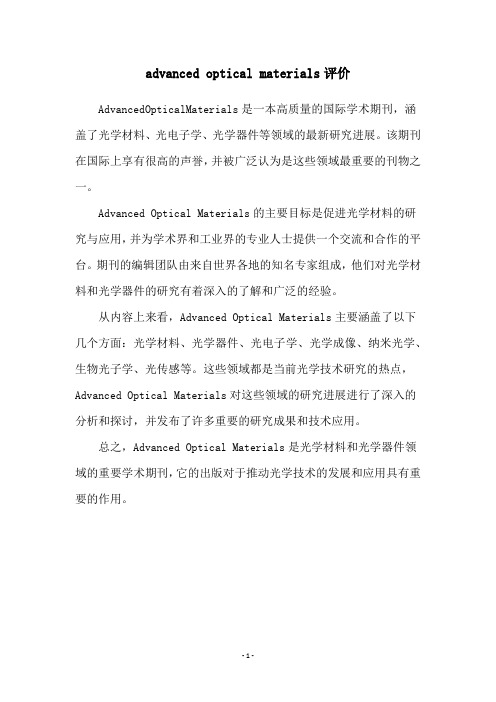
advanced optical materials评价
AdvancedOpticalMaterials是一本高质量的国际学术期刊,涵盖了光学材料、光电子学、光学器件等领域的最新研究进展。
该期刊在国际上享有很高的声誉,并被广泛认为是这些领域最重要的刊物之一。
Advanced Optical Materials的主要目标是促进光学材料的研究与应用,并为学术界和工业界的专业人士提供一个交流和合作的平台。
期刊的编辑团队由来自世界各地的知名专家组成,他们对光学材料和光学器件的研究有着深入的了解和广泛的经验。
从内容上来看,Advanced Optical Materials主要涵盖了以下几个方面:光学材料、光学器件、光电子学、光学成像、纳米光学、生物光子学、光传感等。
这些领域都是当前光学技术研究的热点,Advanced Optical Materials对这些领域的研究进展进行了深入的分析和探讨,并发布了许多重要的研究成果和技术应用。
总之,Advanced Optical Materials是光学材料和光学器件领域的重要学术期刊,它的出版对于推动光学技术的发展和应用具有重要的作用。
- 1 -。
国际光学与光子学会SPIE简介

国际光学与光子学会SPIE简介SPIE成立于1955年,致力于推动以光为基础的技术,服务了超过170个国家。
SPIE 每年组织或赞助近25个大型技术论坛、展览以及培训项目,范围遍及北美、欧洲、亚洲及澳洲。
1957年,出版了第一期SPIE报刊,举办了第一届国家技术研讨会。
1960年,SPIE报刊刊登了第一组技术论文。
1963年,SPIE举办了第一届研讨班形式的会议并出版了第一批会议记录。
1973年,总部从Redondo Beach迁往加州的Palos V erdes。
1975年,协会收入达到50万美元,实现了财政自给。
1977年,成立了协会金牌奖。
总部迁往华盛顿Bellingham。
1995年,举办了成立40周年庆典。
合作赞助了在西安举办的国际传感器应用与电子器件展览会。
2000年,SPIE会员Zhores I. Alferov因在半导体异质结构和高速光电子学方面的贡献获得诺物理学奖。
2003年,SPIE数字图书馆启动,提供了期刊和会议纪要的七万篇文献。
现在的光学和光电子学大都围绕信息光学展开研究。
在集成光信息处理方面,有光计算、光学互连、衍射光学等前沿领域;在成像方面,较热门的技术有光学计算机断层成像和三维共焦成像系统;在光学传感器方面,人们越来越关注三维传感技术;新一代的全息术和光学信息处理技术也亟待开发。
同时,信息光学的材料和装置也成为了热门领域。
更加偏向应用领域的还有人机接口与显示技术。
当然还有很多基础理论问题,如非线性光学、超快光学现象、散射、位相共轭等。
Statement of PurposeSPIE is an international society advancing an interdisciplinary approach to the science and application of light.About the SocietySPIE is the international society for optics and photonics founded in 1955 to advance light-based technologies. Serving approximately 180,000 constituents from more than 170 countries, the Society advances emerging technologies through interdisciplinary information exchange, continuing education, publications, patent precedent, and career and professional growth.SPIE annually organizes and sponsors approximately 25 major technical forums, exhibitions, and education programs in North America, Europe, Asia, and the South Pacific.In 2010, the Society provided more than $2.3 million in support of scholarships, grants, and other education programs around the world.SPIE publishes the SPIE Digital Library, containing more than 313,000 research papers from the Proceedings of SPIE and the Society's 9 scholarly journals with around 18,000 new papers added each year, and more than 120 eBooks from the SPIE Press catalog. The SPIE Press publishes print monographs, tutorial texts, Field Guides, and reference books. SPIE also publishes a wide variety of open access content.Membership includes Fellows and Senior Member programs. The Society has named morethan 900 SPIE members as Fellows since 1955, and implemented its Senior Membe r program in 2008.SPIE's awards program serves to recognize outstanding contributions from individuals throughout the scientific community regardless of membership status.History of the SocietySPIE TIMELINE: 1955-Present1955 - On July 1, the Society of Photographic Instrumentation Engineers is founded to specialize in the application of photo-optical instrumentation. The Society's first local technical meeting is held in Los Angeles on August 8.1956 - Incorporated as Society of Photographic Instrumentation Engineers in the State of California. The Society produces its first product display (Exhiborama) with 250 in attendance. First 100 Members.1957 - The first SPIE Newsletter is published. The first national technical symposium is produced. Membership in SPIE reaches 200.1958 - Karl Fairbanks Memorial Award established. The third SPIE Symposium marks the first time government agencies cosponsor an SPIE symposium.1959 - A. J. Carr is hired as first full-time executive secretary. The first photo-instrumentation course is organized through the University of California at Los Angeles.1960 - The SPIE Newsletter publishes its first group of technical papers. The SPIE Sustaining Membership category is created. First Honorary Membership awarded to Lewis Larm ore.1961 - Membership in SPIE reaches 1,000. George W. Goddard Award is established to recognize exceptional achievement in optical or photonic instrumentation for aerospace, atmospheric science, or astronomy.1962 - The official Society of Photographic Instrumentation Engineers Journal is launched with an October/November issue.1963 - SPIE holds its first technical seminar-type conference and publishes its first official proceedings, on image enhancement.1964 - The Journal is renamed the Society of Photo-Optical Instrumentation Engineers Journal to reflect the Society's formal name change to the "Society of Photo-Optical Instrumentation Engineers."1965 - The SPIE Newsletter name is changed to SPIE-GLASS. The number of national SPIE Chapters reaches 15.1966 - President's Award is established to recognize meritorious service of outstanding benefit to the Society. Award is given by the President and the Board of Directors. SPIE holds four technical conferences.1967 - Demand for technical conferences continues to grow; SPIE meets demand by offering 4 more technical conferences and supporting Proceedings. SPIE income reaches $50,000.1968 - Physical Optics Notebook, by Parrent and Thompson, is published.1969 - Membership reaches 1,200 and Sustaining Membership reaches 50. SPIE holds five technical conferences. Joseph Yaver is hired as Executive Director.1970 - Journal name changed to Journal SPIE, and SPIE-GLASS is included in Journal. Tabletop Exhiborama is established as SPIE hallmark at the Fiber Optics meeting in Dallas, Texas. SPIE produces its first meeting in Japan.1971 - Journal name changed to Journal of the Society of Photo-Optical Instrumentation Engineers (SPIE). Albert M. Pezzuto Award is established to recognize a currently serving or former national officer or director who has given exceptional service to the Society. SPIE holds six technical conferences.1972 - The SPIE Journal name changes to Optical Engineering. The 100th Sustaining Member enrolls in SPIE. SPIE holds eight technical conferences.1973 - National Headquarters moves from Redondo Beach to Palos Verdes, California. SPIE holds 11 technical conferences.1974 - Rudolf Kingslake Medal and Prize is established for recognition of the most noteworthy paper to appear in Optical Engineering. SPIE holds 10 technical conferences.1975 - The Society becomes financially viable with income reaching $500,000. SPIE holds 16 technical conferences. SPIE presents author manuscript kit at all its conferences.1976 - SPIE holds 27 technical conferences. SPIE celebrates its 20th Anniversary with Brigadier General George W. Goddard and Rudolf Kingslake being honored guests.1977 - The Gold Medal of the Society Award is established to recognize outstanding engineering or scientific accomplishments in optics, electro-optics, or photographic technologies or applications. The Society Headquarters is moved to Bellingham, Washington. SPIE income reaches $1,000,000. Membership is 2,000. The 100th Proceedings Volume is published.1978 - Educational Fund established to foster educational activities in optical engineering. SPIE holds 36 technical conferences.1979 - Proceedings Volume 200 is published. The SPIE Technology Achievement Award is established to recognize outstanding accomplishments in optical, electro-optical, or photonics engineering technologies. SPIE holds 46 technical conferences. The Society establishes its first European office.1980 - Membership reaches 3,000. SPIE Headquarters reaches 30 full-time employees. The Society purchases land in Bellingham, Washington, for future construction of International Headquarters. The number of technical papers doubles in the SPIE Journal, Optical Engineering.1981 - To reflect its rapidly changing Membership and fast-paced technology, the Society name is officially defined as SPIE - The International Society for Optical Engineering. The Society celebrates its 25th Anniversary in San Diego, California, with a record 21 technical conferences, 160 instrument displays, and 18 tutorials. SPIE reaches milestones of 4,000 Members and 5,000 exhibitors. Over 10,000 papers are published in SPIE Proceedings and Optical Engineering. Over 150,000 copies of SPIE Proceedings and Journals are distributed.1982 - SPIE is appointed International Secretariat for the 15th International Congress onHigh-Speed Photography and Photonics. SPIE holds five major symposia.1983 - The First International Technical Symposium (Geneva, Switzerland) has 1,300 attendees from 26 countries. Due to demand in various technical areas, new Technical Wor king Groups are formed. The Dennis Gabor Award is established to recognize outstanding inventive accomplishments in optical systems. International Headquarters is officially dedicated in Bellingham, Washington.1984 - OE Reports is launched to provide monthly news and commentary for the optical engineering community. Membership reaches 5,000. Optical Engineering circulation exceeds7,000. The total number of Proceedings Volumes distributed since their inception reaches 200,000. SPIE holds more than 70 conferences worldwide.1985 - Optics Education, the first survey of graduate and undergraduate programs in optics and optoelectronics, is published. SPIE and the ANRT-Association Nationale de la Recherchâ Technique, co-organize a three-year European conference series.1986 - Two new symposia are introduced, OE/LASE in Los Angeles and Technical Symposium Southeast in Orlando. The Society celebrates its 30th Anniversary in San Diego, California.1987 - The Society expands its presence in Europe with additional cha pters, events, and meetings. An agreement is reached with the European Physical Society and Europtica Services I. C. to cosponsor a series of International Congresses for the next four years.1988 - SPIE establishes the SPIE Optical Engineering Press to provide a framework for its special scholarly publications.1989 - OE Reports circulation exceeds 70,000. SPIE boasts 200 Sustaining Members. SPIE publishes its first Tutorial Text. The Harold E. Edgerton Award is given for the first time. Membership reaches 10,000.1990 - The Society establishes an SPIE Soviet Union Chapter, making it the first UnitedStates-based scientific and engineering society to open a chapter in the then-U.S.S.R. SPIE also establishes Chapters in Poland and Hungary. International Headquarters expansion is completed in September.1991 - Representatives of SPIE and the newly formed European Optical Society (EOS) sign the EUROPTO joint venture agreement, improving international collaboration in organizing optics events in Europe. The SPIE Annual Index of Proceedings Papers, the Society's first such publication, is introduced in May.1992 - SPIE develops its first fully operational Internet site with plans for a complete online services expansion. The quarterly Journal of Electronic Imaging debuts, co-published by SPIE and IS&T.1993 - After 24 years as Executive Director of SPIE, Joe Yaver announces his retirement. Jim Pearson is appointed new Executive Director. SPIE Press publishes The Infrared & Electro-Optical Systems Handbook. A Proceedings milestone is reached when the Society publishes its 2,000th Volume. SPIE cosponsors the first Symposium on Coupling Technology to National Need in Albuquerque, New Mexico.1994 - SPIE offers its first-ever CD-ROM Proceedings at the Electronic Imaging Symposium. makes its debut. The Photonics East symposium is inaugurated. SPIE opens a satellite office in Bergen, Norway. Continuing Education Units are offered for short courses at the AeroSense Symposium in Orlando, Florida.1995 - SPIE celebrates its 40th anniversary. Photonics West debuts in San Jose, California.C o-located with the Photonics West Event is the SPIE/IS&T Electronic Imaging Event. SPIE cosponsors Photomask in Kawasaki City, Japan, with SPIE Japan and BACUS. SPIE and COEMA cosponsor the International Sensors Application and Electronic Components Exhibition in Xi'an, Shaanxi, China.1996 - The Journal of Biomedical Optics is introduced and publishes four quarterly issues. The Photonics Resource Center on the World Wide Web () is launched. SPIE and OSA cooperate to lead the formation of the Coalition for Photonics and Optics.1997 - Photonics West is a huge success with over 10,000 attendees and 415 exhibitors. Membership reaches all-time high with over 13,500 Individual Members and 317 Corporate Members. The number of SPIE Regional Chapters reaches a high of 21 in over 17 different countries. SPIE Journals from 1996 are available for the first time on a single, searchable, readable, and printable CD-Rom. The SPIE Women in Optics Technical Community is formed.1998 - SPIE introduces the first CD-ROM short course at the 1998 Photonics West Event. SPIE Journals become available online. The Society starts the year with over 13,750 Members. Members nominate 21 new Fellows to the Society.1999 - After more than 5 years as Executive Director of SPIE, Jim Pearson resigns. Eugene G. Arthurs is appointed Executive Director. SPIE Membership continues to grow and reaches anall-time high with 14,338 individual members.2000 - SPIE launches Optical Networks Magazine covering the technologies, architectures, services, and applications in the field of optical telecommunications and networking systems. The SPIE Scholarship Committee awards over $220,000 in Scholarships and Grants. SPIE Member Zhores I. Alferov wins the Nobel Prize in Physics for his role in developing semiconductor heterostructures used in high-speed optoelectronics.2001 - In January, oemagazine launches. This new Member publication focuses on optics, photonics, and Society happenings. The SPIE European Satellite office opens in Cardiff, United Kingdom, with Karin Burger as Manager.2002 - The SPIE Journal of Microlithography, Microfabrication, and Microsystems (JM3) debuts in March. MySPIE offers Authors, Chairs, Committee Members, and other constituents a web-based manuscript submission program to give these audiences better support.2003 - SPIE Digital Library is launched, offering 70,000 full-text papers from SPIE Journals and Conference Proceedings. SPIE and OSA secure a $1.7 million NSF grant that will actively involve students, parents, teachers, school districts, and their greater communities in the areas of science and engineering. The SPIE Scholarship Committee awards over $200,000 in scholarships and grants to more than 80 individuals and educational or research institutions worldwide.2004 - SPIE holds two new events to meet the demands of researchers and engineers: Optics East and Photonics Europe. The Society's largest-ever European astronomy event - Astronomical Telescopes - was held in Glasgow, Scotland, with over 2,000 a ttendees. SPIE Press introduces the Field Guide Series with four titles: Field Guide to Visual and Ophthalmic Optics; Field Guide to Adaptive Optics; Field Guide to Atmospheric Optics; Field Guide to Geometrical Optics. The SPIE Digital Library includes more than 120,000 technical papers from SPIE Journals and Conference Proceedings, including full coverage from 1998 to the present. The Society provides more than $700,000 in scholarships, grants, and financial support to encourage scientific and technological education. SPIE Membership reaches an all-time high of 16,550 Members.2005 - SPIE celebrates its 50th anniversary in San Diego, California in conjunction with the SPIE Optics and Photonics Symposium. The SPIE Digital Library is extended back to 1990 and surpasses 200,000 online papers. SPIE Europe and the SPIE Polish Chapter teamed up on new International Congress on Optics & Optoelectronics in Warsaw, Poland.2006 - The SPIE Newsroom online magazine and SPIE Professional member magazine are launched. Two electronic journals, the Journal of Nanophotonics and the Journal of Applied Remote Sensing, are announced. Membership is over 17,000 and SPIE has 91 Student Chapters throughout the world. An all-time record number of 41,000 attended SPIE events. SPIE's APOC (Asia-Pacific Optical Communications) symposium was held for the first time outside of China in Korea, with co-sponsors OSK, KAPID and Gwangju City. And for the first time ever, SPIE sponsore d a meeting in India: The Asia-Pacific Remote Sensing Symposium was held in Goa.2007 - SPIE retires its DBA (The International Society for Optical Engineering) and determines that SPIE will be the name under which the Society continues to do business, con tinuing a long history of supporting an interdisciplinary approach to the science and application of light.2008 - The SPIE Digital Library passes the 250,000-article milestone. SPIE announces the move from San Jose to San Francisco for Photonics West 2010. SPIE discontinues regional chapters and welcomes the launch of new socie ties from Hong Kong and Poland. Nobel Laureate John C. Mather speaks at SPIE Astronomical Instrumentation in Marseille, France. The SPIE Newsroom wins a 2008 EXCEL Award from the Society of National Association Publications (SNAP). SPIE installs a new 15kW solar electric system on the roof of its Bellingham, WA, headquarters. SPIE joinswith Photonics Media to launch the first annual Prism Awards for Photonics Innovation. Taipei holds first-ever SPIE Lithography Asia conference. The first "Senior Members" are announced.2009 - SPIE Board Member (2006-2008) Kristina Johnson nominated to be U.S. Under Secretary of Energy. SPIE launches new e-journal, Journal of Photonics for Energy. SPIE appoints Ron Driggers editor of Optical Engineering and Lihong Wang editor of Journal of Biomedical Optics. Richard Hoover receives the Gold Medal of the Society. Photonics visionary Späth honored at SPIE Europe Optical Metrology congress. SPIE awards $292,000 in scholarships. SPIE celebrates the telescope's 400 year anniversary. SPIE joins in urging more U.S. visa process review and changes. SPIEWorks is named among top web employment sites by Weddle's 2009/10 Guide. SPIE launches online courses in optics and photonics. SPIE and Japan Society of Applied Physics sign collaboration agreement.。
光学领域的会议等级

光学领域的会议等级在光学领域,会议是学术交流和合作的重要平台。
不同会议的等级代表了其学术水平和影响力的高低。
本文将介绍光学领域中几个重要的会议等级。
1. 国际光学工程学会(SPIE)会议:SPIE是全球最大的光学学会之一,每年举办多个国际会议。
这些会议涵盖了光学和光电子学的各个领域,包括光学器件、光学系统、光学材料等。
SPIE会议的等级非常高,汇集了世界各地的顶级科学家和工程师,是光学领域最重要的学术交流平台之一。
2. 国际光学学会(OSA)会议:OSA是国际光学学会,也是光学领域最具影响力的学会之一。
该学会每年举办多个重要会议,包括光子学、激光技术、光通信等领域。
OSA会议的学术水平很高,吸引了全球顶尖的光学科学家和工程师参会。
3. 光学学会(Optical Society)会议:光学学会是一个国际性的学术组织,也是光学领域的重要会议之一。
该学会每年举办多个会议,涵盖了光学的各个方面,包括光学测量、光学成像、光学设计等。
光学学会会议的学术质量较高,是光学研究者交流经验和展示研究成果的重要平台。
4. 国际量子光学学会(IQEC)会议:IQEC会议是国际量子光学学会主办的一个重要会议,每两年举办一次。
该会议聚焦于量子光学和量子信息领域,是该领域科学家和工程师的重要交流平台。
IQEC 会议汇集了世界各地的专家学者,展示了最新的研究成果和技术应用。
5. 国际光子学会议(ICP):ICP会议是国际光子学会主办的一系列会议,旨在促进光子学领域的学术交流和合作。
该会议涵盖了光子学的各个方面,包括光子学器件、光子学材料、光子学应用等。
ICP 会议的学术水平较高,吸引了众多光子学领域的专家学者参与。
除了上述几个国际性的光学会议,还有一些地区性和专业性的会议也具有一定的学术影响力。
例如,欧洲光学学会(EOS)会议、亚洲光学学会(AOS)会议等都是光学领域的重要学术交流平台。
参加这些高水平的光学会议对于研究人员和工程师来说非常重要。
光学SCI期刊及影响因子

光学SCI期刊及影响因子光学是一门研究光的传播、发射、准直与控制,以及与物质相互作用的学科。
随着光学技术的发展,越来越多的研究成果被发表在各种SCI期刊上。
在此我将介绍几个光学领域的SCI期刊以及它们的影响因子。
1. "Optics Express"(光学快报)是一个广受欢迎的、高影响力的光学领域SCI期刊。
该期刊每周发表高质量的研究论文,包括光学、光子学、传感器和光学通信领域的研究。
该期刊的影响因子在2024年达到了3.562. "Optics Letters"(光学快报)是美国光学学会的一本期刊,主要发表光学和光子学领域的研究成果。
该期刊每年出版大约1300篇论文,其中很多是高影响力的研究成果。
"Optics Letters"的影响因子在2024年达到了3.843. "Applied Optics"(应用光学)是一个广泛涵盖光学应用领域的SCI期刊。
该期刊涵盖了光学材料、光学设计、光学成像、光学传感器等方面的研究成果。
"Applied Optics"的影响因子在2024年达到了1.964. "Photonics Research"(光子学研究)是一个专注于光子学领域的SCI期刊。
该期刊包括光电子学、材料学、光学器件等方面的研究成果。
“Photonics Research”的影响因子在2024年达到了8.035. "Journal of Optics"(光学杂志)是英国皇家光学学会的官方期刊,发表包括基础光学和应用光学在内的研究成果。
该期刊的影响因子在2024年达到了2.22这只是光学领域中一小部分SCI期刊的例子,还有很多其他的SCI期刊也涵盖了光学相关领域的研究成果。
选择适合自己研究领域的SCI期刊发表论文是非常重要的,不仅可以提升科研成果的可见度和影响力,还可以为个人的学术发展提供支持。
optics express的参考格式

Optics Express是光学领域内的一本国际学术期刊,该期刊由Optical Society of America出版,主要刊载与光学相关的原创性研究论文,涵盖了光学物理、光学工程、光电子学和激光技术等多个学科领域。
本文将从Optics Express的参考文献格式入手,逐步介绍光学领域中学术论文中参考文献的格式要求和注意事项。
一、期刊文章的参考文献格式期刊文章是学术研究中常见的文献类型,其参考文献的格式一般包括作者、文章题目、期刊名称、卷号、期号、页码和出版年份等信息。
对于Optics Express期刊文章的参考文献,通常按照以下格式来书写:[1] 作者1, 作者2. 文章题目. 期刊名称, 年份, 卷号(期号), 页码.例如:[1] Smith J, Johnson L. A study of optical materials. Optics Express, 2018, 26(5), 123-135.在编写期刊文章的参考文献时,需要注意以下几点:1. 作者尊称的书写应按照“姓氏+名字”的格式,多个作者之间使用逗号分隔;2. 文章题目应使用斜体字,并在句末使用句号;3. 期刊名称应列出完整的刊名,并使用斜体字;4. 年份、卷号、期号和页码应按照特定的格式书写,并在逗号后留一个空格。
二、会议论文的参考文献格式光学领域中的研究成果通常还会在国际学术会议上进行发布,因此会议论文也是重要的参考文献来源。
对于Optics Express期刊中刊载的会议论文,其参考文献格式通常为:[2] 作者1, 作者2. 文章题目. 会议名称, 会议地点, 页码, 年份.例如:[2] Brown A, White B. Innovations in optical design. Proc. SPIE 11205, 34th International Conference on Optics, San Francisco, CA, United States, 11205A-1-11205A-8, 2019.在编写会议论文的参考文献时,同样需要遵循作者尊称、文章题目、会议名称、会议地点、页码和年份等要素的书写规范,并且对会议名称等信息使用斜体字。
光电信息科学与工程参考文献

光电信息科学与工程参考文献在光电信息科学与工程领域,有许多经典的参考文献。
以下是一些常用的参考文献,它们涵盖了光电信息科学与工程的各个方面:1. 《现代光学》(Modern Optical Engineering) Warren J. Smith.这本书是光学工程领域的经典教材,涵盖了光学基础、光学元件设计、光学系统等内容,对于理解光学原理和应用非常有帮助。
2. 《光电子学与光通信》(Photonics and Fiber Optics) M. Yasin S. Khan.这本书介绍了光电子学和光通信的基本原理、器件和系统设计,对于光电信息科学与工程的学习和研究都非常有用。
3. 《光电子学导论》(Introduction to Optoelectronics) John Wilson, John Hawkes.这本书系统地介绍了光电子学的基本概念、器件和应用,对于理解光电子学的原理和技术有很大帮助。
4. 《激光原理与技术》(Principles of Lasers) Orazio Svelto.这本书详细介绍了激光的原理、技术和应用,包括激光器的工作原理、激光光束的特性、激光与物质相互作用等内容。
5. 《光电子学》(Optoelectronics) Wilson, Hawkes.这本书涵盖了光电子学的基本理论和应用,包括光电子器件、光电子传感器、光通信等方面的内容。
6. 《光电子学与信息处理》(Optoelectronics andInformation Processing) Ray T. Chen.这本书介绍了光电子学和信息处理的交叉领域,包括光电子器件、光信号处理、光通信等方面的内容。
7. 《光电子学与光通信工程》(Optoelectronics and Fiber Optic Technology) R.P. Khare.这本书详细介绍了光电子学和光通信工程的原理和应用,包括光电子器件、光纤通信系统等方面的内容。
- 1、下载文档前请自行甄别文档内容的完整性,平台不提供额外的编辑、内容补充、找答案等附加服务。
- 2、"仅部分预览"的文档,不可在线预览部分如存在完整性等问题,可反馈申请退款(可完整预览的文档不适用该条件!)。
- 3、如文档侵犯您的权益,请联系客服反馈,我们会尽快为您处理(人工客服工作时间:9:00-18:30)。
中国科学技术信息研究所每年的SCI论文是依据SCIE(网络版)数据进行科技 论文产出统计。随着网络的发展,以后这两者的差别会越来越被淡化。
SCIE论文的网络检索
网址:
ISI Web of Knowledge平台中的 Web of Science
Web of Science 由三个独立的数据库组成(既可以分库检索,也可以多库联 合检索) 。三个数据库分别是Science Citation Index Expanded (简称SCIE)、 Social Sciences Citation Index(简称SSCI)和Arts & Humanities Citation Index (简称A&HCI)。内容涵盖自然科学、工程技术、社会科学、艺术与人文 等诸多领域内的8,500多种学术期刊。
Journal of Optical Networking (JON) (光网络类,已改版)
已改版为: IEEE/OSA Journal of Optical Communications and Networking
Advances in Optics and Photonics (AOP)
(综述、教程类, 2009创刊,new!) Virtual Journal for Biomedical Optics (VJBO) (虚拟刊物,2006年创刊) Optics & Photonics News ( OPN ) (光学光电子领域新闻) Spotlight on Optics Topics( SOT , new!) (OSA期刊中的焦点论文)
光学、光电子学领域 de 著名学会、期刊及文献搜索平台
林志立 北京航空航天大学仪器光电学院光电工程系 Email: zllin2008@ December 3, 2009
本报告的主要内容:
(一)三大文献索引系统(SCI,EI,ISTP)介绍
(二)光学、光电子学领域的著名学(协)会、及 其主办的期刊 (三)高效的科技文献搜索平台及使用方法
其它指标还有: 五年期的影响因子(5-year Impact Factor), 即年指数(immediacy index , 统计当年的论文被引用的情况), 被引半衰期(Cited half-life,反映期刊老化速度)。
附件一:2008年SCIE期刊影响因子.xls 附件二: 2008年SCI核心版收录3769种期刊目.pdf
美国光学信息数据库包含的全部期刊
访问网址:
合作期刊
IEEE Photonics Society IEEE Photonics Society
S.I. Vavilov Optical Institute in Russia
?
SCI和SCIE的区别
SCI 和 SCIE(SCI Expanded)分别是科学引文索引光盘版(核心版)及科学引文索 引扩展版(网络版),前者收录期刊3769种(2008年),后者收录期刊6598种左右 (2008年)。期刊数量是动态变化的。一般情况下,SCI(光盘版)收录的论文包含在 SCIE(网络版)中。前者一般都是期刊质量相对稳定的著名期刊。
2. 工程索引 (Engineering Index, EI)
创刊于1884年,是美国工程信息公司出版的著名工程技术类综合性检 索工具。 EI选用世界上工程技术类期刊2000余种。收录文献几乎涉及工程技术 各个领域。
?
EI (核心版)与EI (非核心版)的区别
Ei Compendex Web是核心版《Ei Compendex》和非核心版《Ei PageOne》合并 而成的Internet版本. EI Compendex 数据库从2009年1月起,所收录的中国期刊 数据不再分核心数据和非核心(PageOne )数据。检索2009 年之前的数据,可 参考以下的核心数据和非核心数据的区别:
(International Society for Optical Engineering )
(4) 中国光学学会 (The Chinese Optical Society )
(1)美国光学学会 (Optical Society of America)
The Optical Society of America (OSA) - Where science and technology innovators in optics and photonics come together.
拟回答的问题:
自然科学和工程技术领域三大索引系统分别是哪些? 光学工程领域相关的著名学(协)会和期刊有哪些? 北航对博士毕业答辩在论文方面的具体要求? 如何高效搜索和本人的研究课题有关的科技文献? 你已写好了篇论文,该如何选择合适的投稿期刊? 你已发表了篇论文,如何确认是被SCI, EI 或ISTP收录?
专利及奖励的论文等同:
【1】本学科领域申请并被授权的发明专利(排名位于学生发明者的第一名有效)等同于SCIE论 文; 【2】申请并被受理的发明专利(排名位于学生发明者的第一名有效)等同于核心期刊论文; 【3】申请者获得国家级科技奖励或省部级科技奖励一等奖1项,且有个人获奖证书,相当于在 SCIE收录源刊物发表1篇论文; 【4】获得省部级科技奖励二等奖(排名前七名)或三等奖1项(排名前五名),相当于在EI收 录源刊物发表1篇论文。
国内高校科技论文现状-以SCI、EI论文为例
2007年部分高校SCI论文数
1 2 3 4 5 38 浙江大学 清华大学 上海交通大学 北京大学 中国科学技术大学 北京航空航天大学 3182 2591 2331 1939 1509 383
2008年部分高校SCI论文数
1 2 3 4 5 35 浙江大学 上海交通大学 清华大学 北京大学 复旦大学 北京航空航天大学 3681 2736 2589 2226 1733 508
SCI有大进步,差距仍较大,EI表现不错 竞争激烈,不进则退!
北航对工科博士申请答辩在论文方面的要求:
申请者在国内外重要的学术期刊或学术会议上发表论文不少于3篇,并满足下列条件 之一: (1)在SCI检索的本学科领域重要国际学术刊物发表1篇学术论文(SCI分区表中 Q1区、Q2区和Q3区,或影响因子0.3以上); (2)分两种情况: 【1】在SCIE收录源刊物发表2篇论文,其中至少1篇发表在国际学术刊物上; 【2】在SCIE收录源刊物发表1篇论文,并且在EI或ISTP收录源刊物或国际会 议上发表2篇论文,其中至少1篇发表在国际学术刊物上; (3)在核心及核心以上刊物(含被ISTP检索的国际会议论文集)上发表的学术论文 总数不少于3篇,其中至少应有2篇文章在EI检索源期刊上发表,并且至少有一篇是用 外文撰写的。
Ei Compendex Web 数据库中的核心和非核心数据的主要区别在于:数据中是否有 分类码(Ei classification codes)和主题词(Ei main heading);有这两项内容的数据 是核心数据,反之是非核心数据。
中信所每年的EI论文是依据EI(核心版)收录的期刊论文数进行产出统计。
Benefits:������ (1) Free Journals: Optics & Photonics News / Physics Today / multiples cards and etc. (2) Free online Journals: select one from OL/ JOSA A/ JOSA B (3) Discount on registration fee of conferences .
IF=1.870 -- Optics, Image Science, and Vision
Journal of the Optical Society of America B (JOSA B)
IF=2.181 - Optical Physics(物理光学) Applied Optics (AO) IF=1.763 (应用光学)
美国光学学会主办的学术期刊
-都是名牌期刊
Optics Express (OE) IF=3.880 版面费:$ 925 <=6Page $1585>=7Page Optics Letters (OL) IF=3.772 limited to 3-Pages Journal of the Optical Society of America A (JOSA A)
创刊于1978年,由美国科学信息研究所(ISI)编辑出版。 该索引收录生命科学、物理与化学科学、农业、生物和环境科学、工 程技术和应用科学等学科的会议文献。 包括一般性会议、座谈会、研究会、讨论会、发表会等。其中工程技 术与应用科学类文献约占35%,其他涉及学科基本与SCI相同。
网络检索:
Web of Science
EI论文的网络检索
Engineering Village
网址:
有些应用类的、工程类的SCI期刊(如Applied Optics) 论文也同时被 EI收录; EI很少收录纯基础理论方面的论文; EI检索库没有影响因子数据。
3. 科技会议录索引(Index to Scientific & Technical Proceedings ,ISTP)
Time flys.
2007年部分高校EI论文数
1 2 3 4 5 8 清华大学 浙江大学 哈尔滨工业大学 上海交通大学 华中科技大学 北京航空航天大学 3393 2897 2828 2748 1545 1376
2008年部分高校EI论文数
1 2 3 4 5 9 清华大学 浙江大学 哈尔滨工业大学 上海交通大学 大连理工大学 北京航空航天大学 3381 3107 2970 2734 1599 1409
SCIE论文的影响因子(Impact Factor, IF or ImF)
它是ISI的期刊引证报告(JCR)中的一项数据,是一个国际上通行 的衡量期刊质量和权威性的重要评价指标。
